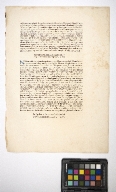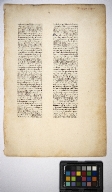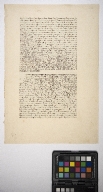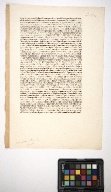|
REFINE
Browse All : leaf
1-5 of 5
Title
De Civitate Dei
Creator
[Sweinheim, Konrad, -1477, Pannartz, Arnold, -approximately 1478, Augustine, of Hippo, Saint, 354-430]
Summary
Folio leaf is an early example of printing from metal types, outside of Germany, where their process of manufacture was invented by Johann Gutenberg, ca. 1455. The text shows old style roman characters with hand-written initial letters.
"St. Augustine (b. 354, d. 430) composed De civitate Dei (The City of God) in response to an attack on Rome by the Visigoth king Alaric I (r. 395–410) in 410. Roman pagans blamed the invasion on the Christian religion, protesting that the ancient gods refused to protect the city out of anger at the adoption of Christianity as the official religion of the Roman Empire in 381. St. Augustine’s text addressed the action of God in the world and in human history, and his collective writings laid the foundation for much of medieval Christian thought." -The British Library
Title
Digesti Novi
Creator
[Wendelin, of Speier, -1477?, Saxoferrato, Bartolus de, 1314-1357]
Summary
This folio leaf shows an example of early Venetian printing by Wendelin da Spira. The characters are old style roman in the classification of serif typefaces. The leaf also includes hand-written paragraph marks in red and blue ink.
Notes by Stephen O. Saxe: "Johann of Speier was one of the many Germans who established presses in Italy in the earliest days of printing. He started in Venice in 1469 and was granted a 5-year monopoly on printing in the city. He died the next year, however, his brother Wendelin printed Latin classics and the first books in the Italian vernacualr. The brothers' roman type still shows traces of manuscript models in the indecisiveness of certain letters, but it is an important step in the direction of type designed for printing alone."
Title
Naturalis historia
Creator
[Jenson, Nicolaus, approximately 1420-1480, Pliny, the Elder]
Summary
This folio leaf shows an example of early Venetian printing by Nicolaus Jenson. The characters are old style roman in the classification of serif typefaces.
Italian translation by Cristoforo Landino.
The Natural History (Latin: Naturalis Historia) ca. 77 CE, is a work by Pliny the Elder. It is one of the largest single works to have survived from the Roman Empire to the modern day and purports to cover all ancient knowledge.
Title
Patavini historici ab urbe condita decadis prim[a]e liber primus incipit
Creator
[Wendelin, of Speier, -1477?, Livy]
Summary
This folio leaf shows an example of early Venetian printing by Wendelin da Spira. The characters are old style roman in the classification of serif typefaces.
The book "History of Rome," sometimes referred to as Ab Urbe Condita ([Books] from the Founding of the City), is a monumental history of ancient Rome, written in Latin between 27 and 9 BC by the historian Titus Livius, or "Livy", as he is usually known in English.
Title
Postilla super totam Bibliam
Creator
[Sweinheim, Konrad, -1477, Pannartz, Arnold, -approximately 1478, De Lyra, Nicolaus, 1270-1349]
Summary
Folio leaf is an early example of printing from metal types, outside of Germany, where their process of manufacture was invented by Johann Gutenberg, ca. 1455. The text shows old style roman characters.
Nicolaus de Lyra was a Franciscan monk, who wrote interpretations of the Christian Bible.
1-5 of 5
|



![Patavini historici ab urbe condita decadis prim[a]e liber primus incipit](https://digitalcollections.rit.edu/MediaManager/srvr?mediafile=/Size1/RIT~1~1/645/cc_csc0144_spira_2631_0001.jpg)
